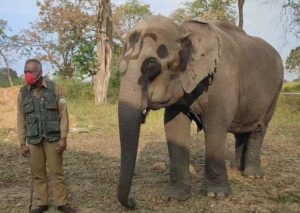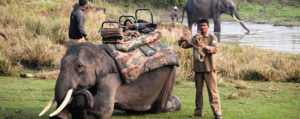 On a sweltering morning in May 2004, a team of forest officials and veterinarians headed to a paddy field in Diphlu Pothar, a village near the Agoratoli range of Kaziranga National Park and Tiger Reserve (KNPTR), in Assam’s Golaghat district. Their mission: to tranquilise a large adult tigress. The tigress, along with two cubs, had recently entered the village and had attacked cattle. A day earlier, the officials had managed to tranquilise the two cubs and release them into the jungle. Now, the tigress remained.
On a sweltering morning in May 2004, a team of forest officials and veterinarians headed to a paddy field in Diphlu Pothar, a village near the Agoratoli range of Kaziranga National Park and Tiger Reserve (KNPTR), in Assam’s Golaghat district. Their mission: to tranquilise a large adult tigress. The tigress, along with two cubs, had recently entered the village and had attacked cattle. A day earlier, the officials had managed to tranquilise the two cubs and release them into the jungle. Now, the tigress remained.
What happened next took the entire team by surprise.
A s they were scouting the area, atop elephants, the tigress suddenly emerged from the field and leapt at one of the two elephants carrying the officials. Satyaban Pegu, a 25-year-old mahout sitting on the elephant named Joymala, was mauled and injured by the tigress.
s they were scouting the area, atop elephants, the tigress suddenly emerged from the field and leapt at one of the two elephants carrying the officials. Satyaban Pegu, a 25-year-old mahout sitting on the elephant named Joymala, was mauled and injured by the tigress.
“I was sitting on the elephant with the mahout [Satyaban] and I fell off. Generally, elephants are scared of tigers and try to flee when they see one. But in this case, Joymala showed great courage and charged towards the tigress. The elephant also tried to pin down the big cat. Eventually, the tigress didn’t attack anyone else and went away. The elephant played a very important role in saving our lives that day,” retired forest official Dharanidhar Boro, who was a ranger at that time, tells Mongabay India.
 R.K. Das, Divisional Forest Officer (DFO) at that time, who was sitting on the second elephant, took a video of the incident, highlighting the important role of elephants and their mahouts in the efficient management of KNPTR.
R.K. Das, Divisional Forest Officer (DFO) at that time, who was sitting on the second elephant, took a video of the incident, highlighting the important role of elephants and their mahouts in the efficient management of KNPTR.
“Mahouts are extremely important in the scheme of things in KNPTR. They are needed for elephant patrolling. They play an important role during the census of various animals like wild water buffaloes, deer, and so on. During floods, they carry rations to the camps in the interiors of jungles which might be inaccessible for vehicles. We consider mahouts and their elephants as our frontline workers. Also, they play a huge role in boosting tourism in KNPTR as elephant safaris are a major draw for tourists,” says Sonali Ghosh, Director of KNPTR. She reveals that KNPTR currently has 67 elephants and 70 mahouts.
History of mahouts in Kaziranga
In 1938, Kaziranga, then a game sanctuary, was opened for tourists for the first time. According to Bubul Sarma, a conservationist and author who grew up near Kaziranga National Park, 305 tourists came to experience elephant rides in 1938-39.
During the British era, wild elephants were caught, domesticated and worked with the forest department. Most mahouts working in the 50s and 60s came from Chhaygaon, Beki, Goalpara, Garo Hills and even Arunachal Pradesh. Later, tribes and people living on the fringes of Kaziranga also joined the profession.
In a self-published book on mahouts of Kaziranga, by Bubul Sarma, he mentions two well-known elephants in the early days of Kaziranga, called Sher Khan and Akbar. Akbar has been cited as a ‘masterpiece of Kaziranga’ in another book, Elephant Gold, by P.D. Stracey who was an IFS officer in Assam in the early 1900s.
“Some of the mahouts like Bihua Gogoi, Belta Gogoi, Mahen Gogoi, Naren Sarkar, and Teli Angu have played a huge role in making Kaziranga what it is today. Mahouts and elephants have been used in the construction of towers and camps in Kaziranga,” says Sarma.
After independence, he says, as new acts were passed for the conservation of wildlife, mahals and sawmills that employed elephants were shut down. “As a result, many of the mahouts became jobless. Later, the forest department bought some elephants and seized a few more for violating norms and they were used for forest work,” he explains.
A generational profession
There was a time when being a mahout was a family profession and each generation would follow the family tradition.
Kiran Rabha, currently the head mahout in the Kohora range of KNPTR with an experience of 41 years, comes from a family of mahouts.
The basic requirement for becoming a mahout is to have the ability to handle elephants, says KNPTR Director Ghosh. “Someone coming from the family of mahouts is already experienced in the basics of handling an elephant, which helps them in becoming a mahout,” she says.
Sarma, however, says that most people in the current generation of mahout families do not opt for the job. “The youngsters in the family are getting an education and can get better jobs. Being a mahout is hard work. They have to devote their entire time to the elephant, taking care of its food, bathing and illnesses. The money is less when compared to the amount of work,” he says.
According to a source in the forest department, while the mahouts who have a permanent job get a salary of over Rs. 40,000 a month, many mahouts are only hired casual workers with a salary less than Rs. 15,000 a month.
Prahlad Gogoi, son of a senior mahout Bubul Gogoi who passed away two years ago in a road accident, doesn’t want to become a mahout despite sharing his father’s love for forests. “My father handled a blind elephant called Krishna. He gave more time to Krishna than he gave to us. Among my three brothers, only I share my father’s love for forests. I am working towards becoming a tourist guide and I have completed three seasons in that job. My father supported this dream of mine,” says 21-year-old Prahlad.
This year, Prahlad went to Raipur, Chhattisgarh, to collect the Gaj Gaurav Award for the best mahout conferred to his father posthumously. The award is instituted by the environment ministry for extraordinary performance in the conservation of wild animals.
Interestingly, there is a village called Pilkhana in the Kohora range of Kaziranga which is mainly inhabited by mahouts and their families. Rabha says, “The forest department built quarters for the mahouts in Pilkhana. Later, many mahouts settled in that village after retirement. About 60 families of mahouts live there. There is also an elephant training centre and a guest house for guests of the forest department.”
Challenges and dangers
Being a mahout is not everyone’s cup of tea, as the job involves immense danger. In 2004, after being mauled by the tigress, Satyaban Pegu’s career as a mahout ended as he lost three fingers on his left hand.
“I was immediately taken to Bokakhat Civil Hospital and then to Kushal Kanwar Hospital in Golaghat and finally to Dibrugarh Medical College. I had to stay in the hospital for almost three months. Luckily the department paid for my treatment, and I could retain my job,” says Satyaban. He was later shifted to a desk job and social forestry.
Besides other animals, mahouts are also at risk from their own elephants. In 1999, an 82-year-old American tourist Mary Brumder died when Bhajan, the elephant she was sitting on, was attacked by another elephant called Gadapani. Bhajan’s mahout Binay Ganak, Mary’s nephew Mathew Arundt and another tourist Humoct Howard John were injured.
In 2013, an elephant called Babul threw its mahout Nirmal Barman off its back and trampled him to death.
“Elephants are very intelligent and at the same time, unpredictable. Lack of care from their mahout can make them angry. Also, they become very aggressive when in musth,” says Sarma.
Musth (a Persian word) is a periodic condition in bull elephants characterized by aggressive behavior and accompanied by a large rise in reproductive hormones.Since mahouts also take part in anti-poaching operations, they have to train for long hours at a time. Kasem Ali, the assistant mahout in Kohora, says, “We have to take training on firing guns, swimming, climbing trees, and so on. Sometimes we have to be in jungles for 24 hours at a stretch.”
Currently, if a mahout or any other forest guard loses their life in the line of duty, their family receives a compensation of Rs. 4,00,000 (four lakhs) as per the government norms. This amount is the same for both permanent and casual workers in Kaziranga. However, in the case of permanent workers, their next of kin is offered recruitment on compassionate grounds in the department, which is not available for the casual workers.
Despite these difficulties, some mahouts find wholesome moments with the elephants in their care. Rabha says that most mahouts during their tenure at the department handle at least three-four elephants. He says, “We grow a special bond with the elephants. We have our own codes and languages which only the elephants understand.”
IMAGE CAPTIONS AND CREDITS:
2. Cover of the book titled ‘Kaziranga Rashtriya Udyan r Atandra Prahari- Hati aru Mahout’ (Vigilant Guards Of Kaziranga National Park- Elephant and Mahouts) by Bubul Sarma. Image courtesy of Bubul Sarma.
3. Deceased mahout Bubul Gogoi with blind elephant Krishna. Image courtesy of Bubul Sarma.
4. Akbar (right), known as the masterpiece of Kaziranga on the cover of P D Stracey’s book ‘Elephant Gold’. Image courtesy of Bubul Sarma.



